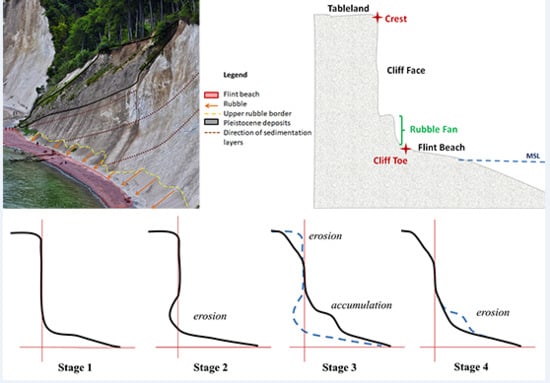Multi-Temporal Cliff Erosion Analysis Using Airborne Laser Scanning Surveys
Abstract
:1. Introduction
2. Materials and Methods
2.1. Study Sites
2.2. Data
2.3. Methodology
3. Results and Discussion
3.1. Volumetric Changes
3.2. Exposure to Erosion
3.3. Rock Resistance
3.4. Correspondence to Morphological Changes
3.5. Model of the Cliff Retreat
4. Conclusions
- Stage 1: Cliff in equilibrium. The vertical cliff has balanced stability, and no talus or material is accumulated on the beach. Waves acts directly on the cliff surface.
- Stage 2: Progressive erosion. Erosion of the cliff toe is caused by wave action. The cliff stability is decreased, and a high degree of erosion occurs along the cliff base.
- Stage 3: Cliff collapse, most likely by toppling. The beach is enriched by material removed from the upper part of the cliff. High erosion of the cliff crest and accumulation on the cliff base occur.
- Stage 4: Talus reduction: Waves act on talus and beach areas to remove accumulated material. Progressive erosion of the talus and beach material occurs until complete removal.
Author Contributions
Funding
Conflicts of Interest
References
- Naylor, L.A.; Stephenson, W.J.; Trenhaile, A.S. Rock coast geomorphology: Recent advances and future reasearch directions. Geomorphology 2009, 114, 3–11. [Google Scholar] [CrossRef]
- Furmańczyk, K.; Andrzejewski, P.; Benedyczak, R.; Bugajny, N.; Cieszyński, Ł.; Dudzińska-Nowak, J.; Giza, A.; Paprotny, D.; Terefenko, P.; Zawiślak, T. Recording of selected effects and hazards caused by current and expected storm events in the Baltic Sea coastal zone. J. Coast. Res. 2014, 70, 338–342. [Google Scholar] [CrossRef]
- Paprotny, D.; Andrzejewski, P.; Terefenko, P.; Furmańczyk, K. Application of Empirical Wave Run-Up Formulas to the Polish Baltic Sea Coast. PLoS ONE 2014, 9, e105437. [Google Scholar] [CrossRef] [PubMed]
- Paprotny, D.; Terefenko, P. New estimates of potential impacts of sea level rise and coastal floods in Poland. Nat. Hazards 2017, 85, 1249–1277. [Google Scholar] [CrossRef]
- Aniśkiewicz, P.; Łonyszyn, P.; Furmańczyk, K.; Terefenko, P. Application of Statistical Methods to Predict Beach Inundation at the Polish Baltic Sea Coast. In Interdisciplinary Approaches for Sustainable Development Goals: GeoPlanet: Earth and Plan; Zielinski, T., Sagan, I., Surosz, W., Eds.; Springer: Berlin, Germany, 2017; pp. 73–92. [Google Scholar]
- Deng, J.; Harff, J.; Zhang, W.; Schneider, R.; Dudzińska-Nowak, J.; Giza, A.; Terefenko, P.; Furmańczyk, K. The Dynamic Equilibrium Shore Model for the Reconstruction and Future Projection of Coastal Morphodynamics. In Coastline Changes of the Baltic Sea from South to East: Past and Future Projection; Harff, J., Furmańczyk, K., VonStorch, H., Eds.; Springer: Berlin, Germany, 2017; pp. 87–106. [Google Scholar]
- Novikova, A.; Belova, N.; Baranskaya, A.; Aleksyutina, D.; Maslakov, A.; Zelenin, E.; Shabanova, N.; Ogorodov, S. Dynamics of Permafrost Coasts of Baydaratskaya Bay (Kara Sea) Based on Multi-Temporal Remote Sensing Data. Remote Sens. 2018, 10, 1481. [Google Scholar] [CrossRef]
- Uścinowicz, G.; Szarafin, T. Short-term prognosis of development of barrier-type coasts (Southern Baltic Sea). Ocean Coast. Manag. 2018, 165, 258–267. [Google Scholar] [CrossRef]
- De Sanjosé Blasco, J.J.; Gómez-Lende, M.; Sánchez-Fernández, M.; Serrano-Cañadas, E. Monitoring Retreat of Coastal Sandy Systems Using Geomatics Techniques: Somo Beach (Cantabrian Coast, Spain, 1875–2017). Remote Sens. 2018, 10, 1500. [Google Scholar] [CrossRef]
- Andriani, G.F.; Walsh, N. Rocky coast geomorphology and erosional processes: A case study along the Murgia coastline South of Barri, Apulia—SE Italy. Geomorphology 2006, 87, 224–238. [Google Scholar] [CrossRef]
- Terefenko, P.; Zelaya Wziątek, D.; Dalyot, S.; Boski, T.; Pinheiro Lima-Filho, F. A High-Precision LiDAR-Based Method for Surveying and Classifying Coastal Notches. ISPRS Int. J. Geo-Inf. 2018, 7, 295. [Google Scholar] [CrossRef]
- Cherith, M.; Robinson, D. Chalk coast dynamics: Implications for understanding rock coast evolution. Earth Sci. Rev. 2011, 109, 63–73. [Google Scholar]
- Wziątek, D.; Vousdoukas, M.V.; Terefenko, P. Wave-cut notches along the Algarve coast, S. Portugal: Characteristics and formation mechanisms. J. Coast. Res. 2011, 64, 855–859. [Google Scholar]
- Terefenko, P.; Terefenko, O. Determining the role of exposure, wave force, and rock chemical resistance in marine notch development. J. Coast. Res. 2014, 70, 706–711. [Google Scholar] [CrossRef]
- Lageat, Y.; Henaff, A.; Costa, S. The retreat of the chalk cliffs of the Pays-de-Caux (France): Erosion processes and patterns. Z. Fur Geomorphol. 2006, 44, 183–197. [Google Scholar]
- Terefenko, P.; Giza, A.; Paprotny, D.; Kubicki, A.; Winowski, M. Cliff retreat induced by series of storms at Międzyzdroje (Poland). J. Coast. Res. 2018, 85, 181–185. [Google Scholar] [CrossRef]
- Fonstad, M.A.; Dietrich, J.T.; Courville, B.C.; Jensen, J.L.; Carbonneau, P.E. Topographic structure from motion: A new development in photogrammetric measurement. Earth Surf. Process Landf. 2013, 38, 421–430. [Google Scholar] [CrossRef]
- James, M.R.; Quinton, J.N. Ultra-rapid topographic surveying for complex environments: The hand-held mobile laser scanner (HMLS). Earth Surf. Process Landf. 2014, 39, 138–142. [Google Scholar] [CrossRef]
- Ružić, I.; Marović, I.; Benac, Č.; Ilić, S. Coastal cliff geometry derived from structure-from-motion photogrammetry at Stara Baška, Krk Island, Croatia. Geo Mar. Lett. 2014, 34, 555–565. [Google Scholar] [CrossRef]
- Uścinowicz, G.; Szarafin, T.; Jurys, L. Tracking cliff activity based on multi temporal digital terrain models–an example from the southern Baltic Sea coast. Baltica 2019, 32, 10–21. [Google Scholar]
- Sallenger, A.H., Jr.; Krabill, W.B.; Swift, R.N.; Brock, J.; List, J.; Hansen, M.; Holman, R.A.; Manizade, S.; Sontag, J.; Meredith, A.; et al. Evaluation of Airborne Topographic Lidar for Quantifying Beach Changes. J. Coast. Res. 2003, 19, 125–133. [Google Scholar]
- Schwarzen, K.; Horst, S. Book section: Germany. In Encyclopedia of the World’s Coastal Landforms; Bird, E.C.F., Ed.; Springer: Berlin, Germany, 2010; Volume 1. [Google Scholar]
- Gunther, A.; Thiel, C. Combined rock slope stability and shallow landslide susceptibility assessment of the Jasmund cliff area (Rugen Island, Germany). Nat. Hazard Earth Syst. 2009, 9, 687–698. [Google Scholar] [CrossRef]
- Buckley, S.J.; Howell, J.A.; Enge, H.D.; Kurz, T.H. Terrestrial laser scanning in geology: Data acquisition, processing and accuracy. J. Geol. Soc. 2008, 165, 625–638. [Google Scholar] [CrossRef]
- Vousdoukas, M.; Kirupakaramoorthy, T.; Oumeraci, H.; de la Torre, M.; Wübbold, F.; Wagner, B.; Schimmels, S. The role of combined laser scanning and video techniques in monitoring wave-by-wave swash zone processes. Coast. Eng. 2014, 83, 150–165. [Google Scholar] [CrossRef]
- Almeida, L.P.; Masselink, G.; Russell, P.E.; Davidson, M.A. Observations of gravel beach dynamics during high energy wave conditions using a laser scanner. Geomorphology 2015, 228, 15–27. [Google Scholar] [CrossRef]
- Korzeniowska, K.; Łącka, M. Generating DEM from LIDAR data-comparison of availabe software tools. Archives of Photogrammetry. Cartogr. Remote Sens. 2011, 22, 271–284. [Google Scholar]
- Campbell, J.B.; Wynne, R.H. Introduction to Remote Sensing; The Guilford Press: New York, NY, USA, 2011. [Google Scholar]
- Hengl, T.; Reuter, H.I. Geomorphometry: Concepts, Software, Application; Elsevier: Amsterdam, The Netherlands, 2009. [Google Scholar]
- Rosser, N.J.; Brain, M.J.; Petley, D.N.; Lim, M.; Norman, E.C. Coastline retreat via progressive failure of rocky coastal cliffs. Geology 2013, 41, 939–942. [Google Scholar] [CrossRef]
- Johnstone, E.; Raymond, J.; Olsen, J.M.; Driscoll, N. Morphological Expressions of Coastal Cliff Erosion Processes in San Diego County. J. Coast. Res. 2016, 76, 174–184. [Google Scholar] [CrossRef]
- Warrick, J.A.; Ritchie, A.C.; Adelman, G.; Adelman, K.; Limber, P.W. New techniques to measure cliff change form historical oblique aerial photographs and structure-for-motion photogrammetry. J. Coast. Res. 2017, 33, 39–55. [Google Scholar] [CrossRef]
- Terefenko, P.; Paprotny, D.; Giza, A.; Morales-Nápoles, O.; Kubicki, A.; Walczakiewicz, S. Monitoring Cliff Erosion with LiDAR Surveys and Bayesian Network-based Data Analysis. Remote Sens. 2019, 11, 843. [Google Scholar] [CrossRef]
- Palaseanu-Lovejoy, M.; Danielson, J.; Thatcher, C.; Foxgrover, A.; Barnard, P.; Brock, J.; Young, A. Automatic Delineation of Seacliff Limits using Lidar-derived High-resolution DEMs in Southern California. J. Coast. Res. 2016, 76, 162–173. [Google Scholar] [CrossRef]
- Kostrzewski, A.; Zwoliński, Z.; Winowski, M.; Tylkowski, J.; Samołyk, M. Cliff top recession rate and cliff hazards for the sea coast of Wolin Island (Southern Baltic). Baltica 2015, 28, 109–120. [Google Scholar] [CrossRef]
- U.S. Army Corps of Engineers. Coastal. Engineering Manual—Chapter 3: Estimation of Nearshore Waves; Corps of Engineers U.S. Army: Washington, DC, USA, 2002. [Google Scholar]
- Fonnesbeck, B.B.; Boettinger, J.L.; Lawley, J.R. Improving a Simple Pressure-Calcimeter Method for Inorganic Carbon Analysis. Soil Sci. Soc. Am. J. 2012, 77, 1553. [Google Scholar] [CrossRef]
- Cleven, R.N. The Role of Dolomite Content on the Mechanical Strength and Failure Mechanisms in Dolomite-Limestone Composites; University of British Colombia: Vancouver, BC, Canada, 2008. [Google Scholar]
- Czubla, P.; Mizerski, W.; Świerczewska-Gładysz, E. Przewodnik Do Ćwiczeń Z Geologii; Wydawnictwo Naukowe PWN: Warszawa, The Netherlands, 2005. [Google Scholar]
- Masselink, G.; Hughes, M.G. Introduction to Coast. Processes & Geomorphology; Hodder Education: London, UK, 2003. [Google Scholar]
- Dornbusch, U.; Robinson, D.A.; Moses, C.; Williams, R.; Costa, S. Retreat of Chalk cliffs in the eastern English Channel during the last century. J. Maps 2006, 2, 71–78. [Google Scholar] [CrossRef]
- Letortu, P.; Costa, S.; Maquaire, O.; Delacourt, C.; Augereau, E.; Davidson, R.; Suanez, S.; Nabucet, J. Retreat rates, modalities and agents responsible for erosion along the coastal chalk cliffs of Upper Normandy: The contribution of terrestrial laser scanning. Geomorphology 2015, 245, 3–14. [Google Scholar] [CrossRef]
- El Khattabi, J.; Carlier, E.; Louche, B. The Effect of Rock Collapse on Coastal Cliff Retreat along the Chalk Cliffs of Northern France. J. Coast. Res. 2018, 341, 136–150. [Google Scholar] [CrossRef]
- Niemeyer, J.; Rottensteiner, F.; Kuhn, F.; Sorgel, U. Extraktion geologisch relevanter Strukturen auf Rügen in Laserscanner-Daten. DGPF Tag. Wien 2010, 19, 298–307. [Google Scholar]

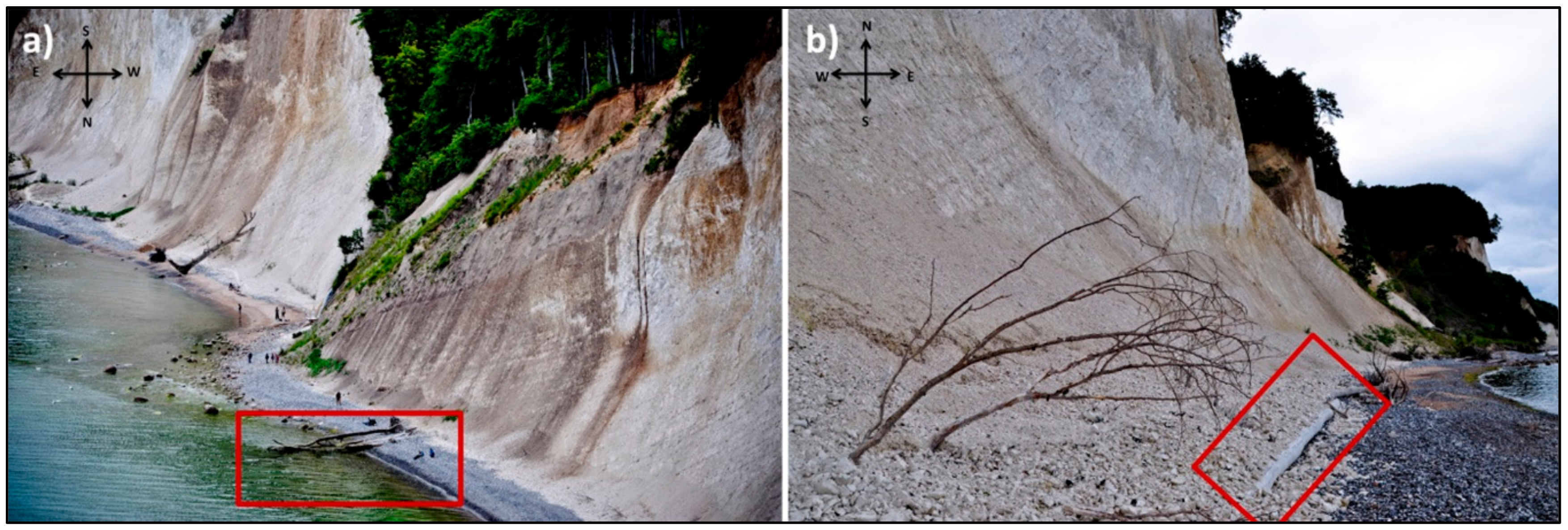
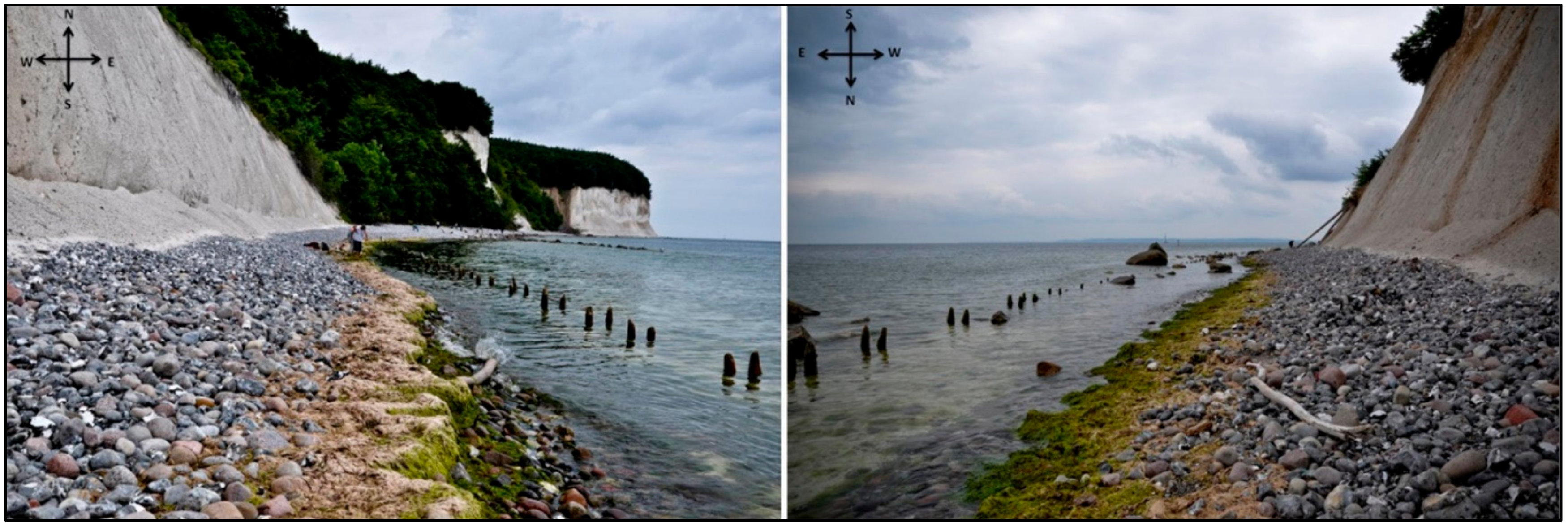
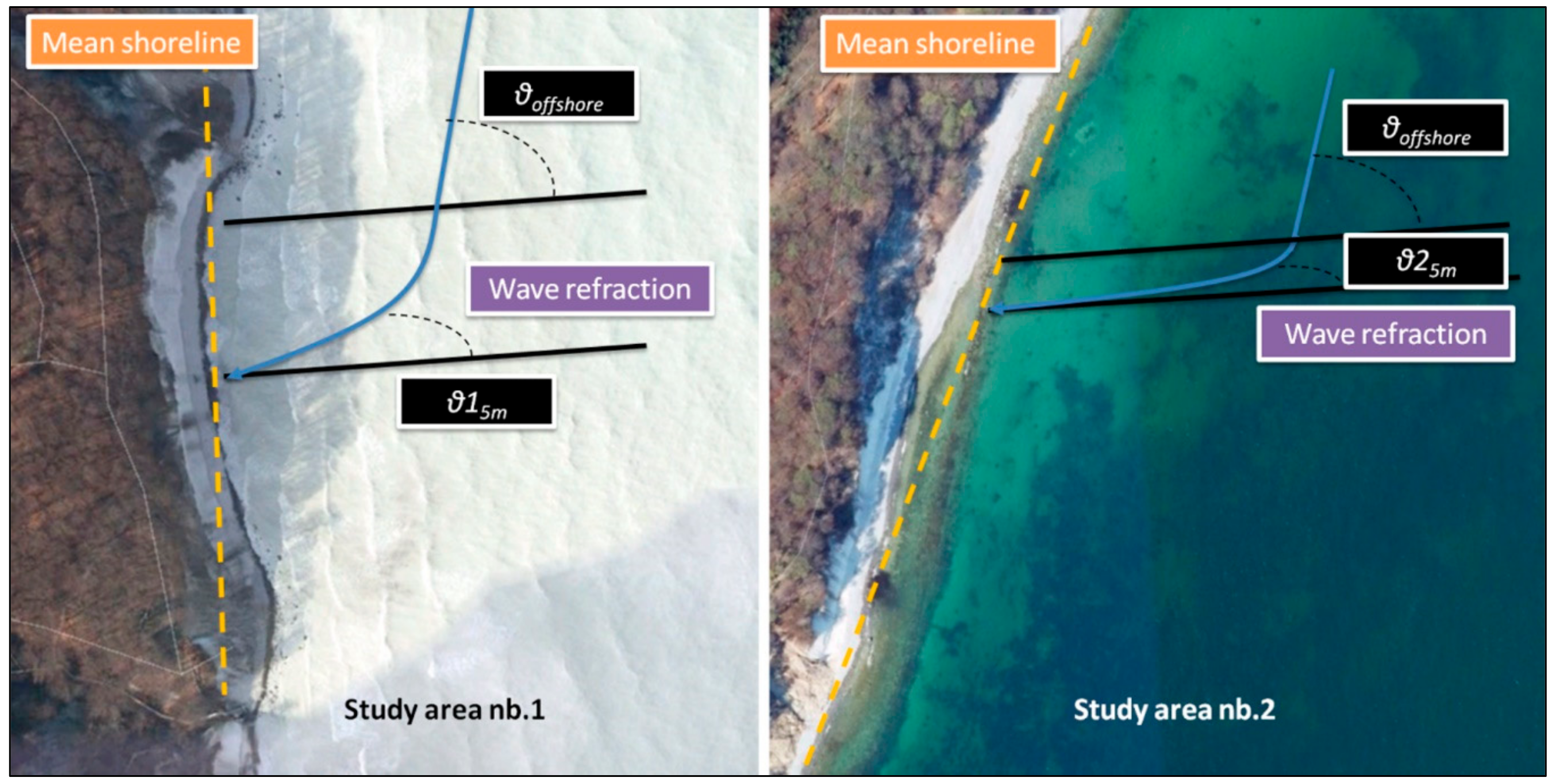
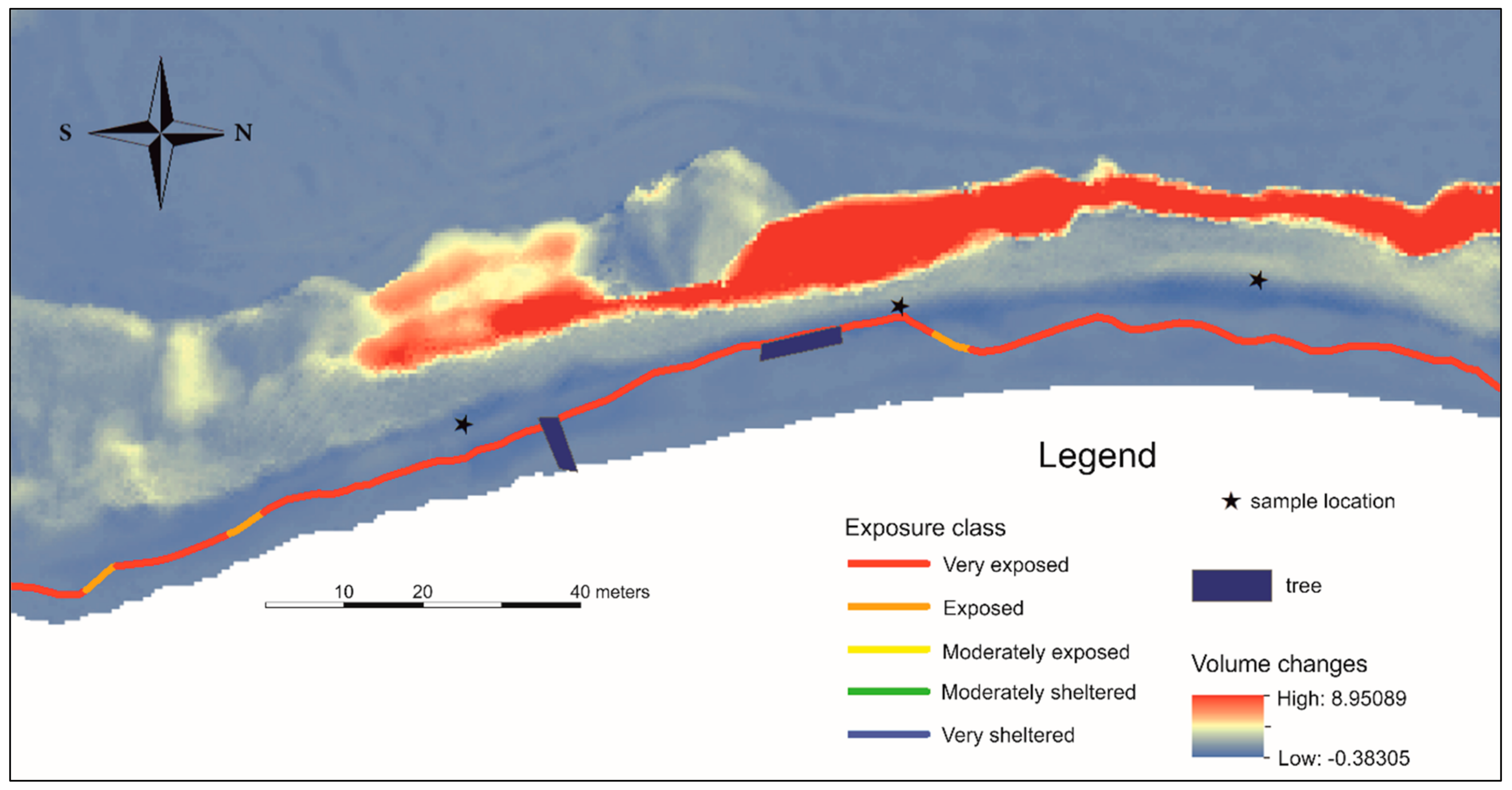

| Class | Exposure | Wave Power Range (W/m) |
|---|---|---|
| 1 | Very exposed | 2460.1–2780 |
| 2 | Exposed | 2140.1–2460 |
| 3 | Moderately exposed | 1820.1–2140 |
| 4 | Moderately sheltered | 1500.1–1820 |
| 5 | Sheltered | 1178–1500 |
| Volume (m3) | Area m2 | Volume Change (m2) | Percentage of Total Area | Ratio (erosion/accumulation) | |||
|---|---|---|---|---|---|---|---|
| AREA 1 | Cliff | Erosion | 19260.35 | 3503.50 | 5.50 | 98.10 | 51.52 |
| Accumulation | 15.60 | 68.00 | 0.23 | 1.90 | |||
| Talus | Erosion | 238.73 | 289.50 | 0.82 | 38.96 | 0.64 | |
| Accumulation | 251.36 | 53.50 | 0.55 | 61.04 | |||
| Beach | Erosion | 33.64 | 443.50 | 0.08 | 27.07 | 0.37 | |
| Accumulation | 238.73 | 1194.75 | 0.20 | 72.93 | |||
| AREA 2 | Cliff | Erosion | 15167.41 | 12314.75 | 1.23 | 92.52 | 12.38 |
| Accumulation | 315.34 | 995.00 | 0.32 | 7.48 | |||
| Talus | Erosion | 818.93 | 942.25 | 0.87 | 91.26 | 10.44 | |
| Accumulation | 6.08 | 90.25 | 0.07 | 8.74 | |||
| Beach | Erosion | 2768.97 | 3247.25 | 0.85 | 92.98 | 13.25 | |
| Accumulation | 42.89 | 245.00 | 0.18 | 7.02 | |||
| Study Area 1 | Study Area 2 | |||
|---|---|---|---|---|
| Recession (m) | Total | Per year | Total | Per year |
| Cliff crest | 2.70 | 0.45 | 0.63 | 0.11 |
| Cliff base (vertical) | 2.6 | 0.43 | 1.15 | 0.19 |
| Cliff base (with talus) | 2.45 | 0.41 | 3.43 | 0.57 |
| Average | 2.58 | 0.43 | 1.74 | 0.29 |
© 2019 by the authors. Licensee MDPI, Basel, Switzerland. This article is an open access article distributed under the terms and conditions of the Creative Commons Attribution (CC BY) license (http://creativecommons.org/licenses/by/4.0/).
Share and Cite
Zelaya Wziątek, D.; Terefenko, P.; Kurylczyk, A. Multi-Temporal Cliff Erosion Analysis Using Airborne Laser Scanning Surveys. Remote Sens. 2019, 11, 2666. https://doi.org/10.3390/rs11222666
Zelaya Wziątek D, Terefenko P, Kurylczyk A. Multi-Temporal Cliff Erosion Analysis Using Airborne Laser Scanning Surveys. Remote Sensing. 2019; 11(22):2666. https://doi.org/10.3390/rs11222666
Chicago/Turabian StyleZelaya Wziątek, Dagmara, Paweł Terefenko, and Apoloniusz Kurylczyk. 2019. "Multi-Temporal Cliff Erosion Analysis Using Airborne Laser Scanning Surveys" Remote Sensing 11, no. 22: 2666. https://doi.org/10.3390/rs11222666
APA StyleZelaya Wziątek, D., Terefenko, P., & Kurylczyk, A. (2019). Multi-Temporal Cliff Erosion Analysis Using Airborne Laser Scanning Surveys. Remote Sensing, 11(22), 2666. https://doi.org/10.3390/rs11222666





